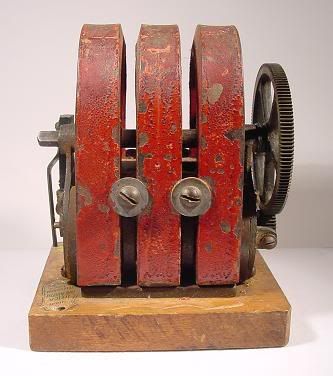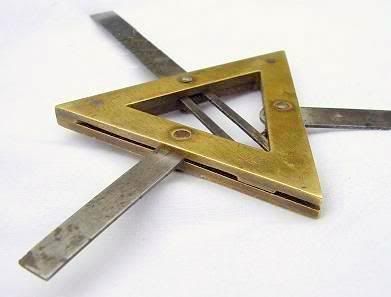Set 142
811. 5-5/8" tall:



The remaining pictures in this set were shot at the Mid-West Tool Collectors Association meeting last week, thanks to everyone there who allowed me to take these photos of their tools.
812. 5-1/2" long, the two upper pieces can be rotated:


813. 2" diameter

814. Approx. 4" tall:


A similar device, 5" diameter; along with naming these items also describe what profession used them and where:

815. 8" long, from the collection of Jim Moffet:

The two end pieces can pivot relative to one another, most likely used with the pieces at angle of 30 degrees or less.

816. Approx. 10" long, though it was probably used for numerous purposes, name the two particular things that this tool was primarily used with:


Answers
Last week's set is seen below, click here to view the entire post:




The remaining pictures in this set were shot at the Mid-West Tool Collectors Association meeting last week, thanks to everyone there who allowed me to take these photos of their tools.
812. 5-1/2" long, the two upper pieces can be rotated:


813. 2" diameter

814. Approx. 4" tall:


A similar device, 5" diameter; along with naming these items also describe what profession used them and where:

815. 8" long, from the collection of Jim Moffet:

The two end pieces can pivot relative to one another, most likely used with the pieces at angle of 30 degrees or less.

816. Approx. 10" long, though it was probably used for numerous purposes, name the two particular things that this tool was primarily used with:


Answers
Last week's set is seen below, click here to view the entire post:


5 Comments:
811. Generator.
813. magnetic field detector.
814. wind speed meter for airports.
815. reciprocal angle finder.
816. scale for shot?
By Anonymous, at 11/02/2006 3:56 PM
Anonymous, at 11/02/2006 3:56 PM
811. generator, used on handcranked telephones.
814. Anemometer. used for measuring wind speed, I have one that shows wind in Feet per minute, needs to be used in conjunction with a watch or clock.
816. strain gauge?
By Anonymous, at 11/02/2006 6:08 PM
Anonymous, at 11/02/2006 6:08 PM
812 - Spider bevel
By Anonymous, at 11/03/2006 12:23 AM
Anonymous, at 11/03/2006 12:23 AM
811 from an old style wooden crank telephone. it generated current to ring the operator.
By Anonymous, at 11/03/2006 12:54 AM
Anonymous, at 11/03/2006 12:54 AM
Some of these answers are correct, please see the answer link for more details.
By Rob H., at 11/03/2006 5:26 PM
Rob H., at 11/03/2006 5:26 PM
Post a Comment
<< Home